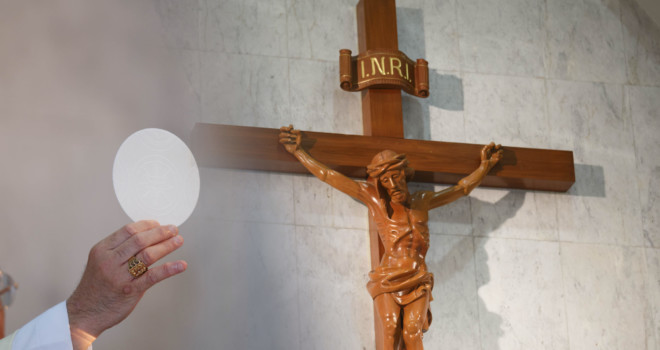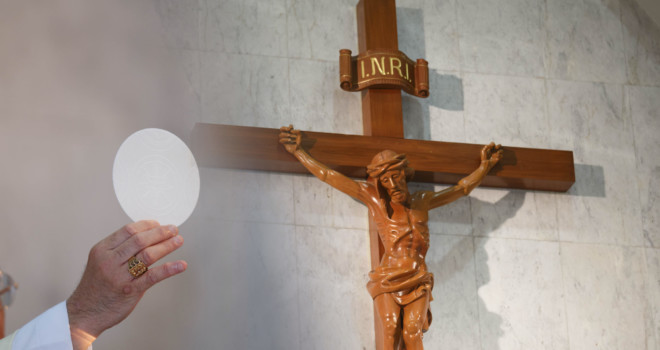The Sacrament of the Eucharist has two sides: it is both a sacrifice and a sacrament. Inasmuch as biological life is nothing but a reflection, a dim echo, and a shadow of the divine life, one can find analogies in the natural order for the beauties of the divine. Does not nature itself have a double aspect: a sacrifice and a sacrament? The vegetables which are served at table, the meat which is presented on the platter, are the natural sacraments of the body of man. By them he lives. If they were endowed with speech, they would say: “Unless you have communion with me, you will not live.”
But if one inquires as to how the lower creation of chemicals, vegetables, or meats came to be the sacrament or the communion of man, one is immediately introduced to the idea of sacrifice. Did not the vegetables have to be pulled up by their roots from the earth, submitted to the law of death, and then pass through the ordeal of fire before they could become the sacrament of physical life, or have communion with the body? Was not the meat on the platter once a living thing, and was it not submitted to the knife, its blood shed on the soil of a natural Gethsemane and Calvary before it was fit to be presented to man?
Nature, therefore, suggests that a sacrifice must precede a sacrament; death is the prelude to a communion. In some way, unless the thing dies, it does not begin to live in a higher kingdom. To have, for example, a Communion service without a sacrifice would be, in the natural order, like eating our vegetables uncooked, and our meat in the raw. When we come face to face with the realities of life, we see that we live by what we slay. Elevating this to the supernatural order, we still live by what we slay.
It was our sins that slew Christ on Calvary, and yet by the power of God risen from the dead and reigning gloriously in Heaven, He now becomes our life and has communion with us and we with Him. In the divine order, there must be the Sacrifice or the Consecration of the Mass before there can be the sacrament or the Communion of the soul and God.
Relation of Baptism and the Eucharist
Baptism is the initiation to the Christian life, and corresponds in the biological order to the beginning of life. But the birth to divine life comes only through a death; that is to say, an immersion under water which mystically symbolizes dying and being buried with Christ. The Eucharist is a sacrifice; it also incorporates us to the death of Christ. Baptism, however, is a more passive representation of that death, particularly in an infant, where the will of the infant does not submit to it, except through the sponsors. The Eucharist is a much more active representation of the death of Christ because the Mass is an unbloody presentation of the sacrificial death of Christ outside the walls of Jerusalem.
The Fathers of the Church were constantly struck by the relationship between Baptism and the Eucharist; the blood and the water which flowed from the side of Christ on the Cross had deep significance. Water was the symbol of our regeneration and, therefore, betokened Baptism; blood, the price of our Redemption, was the sign of the Eucharist.
This brings up the question, if there is a relationship to the death of Christ in both sacraments, what is the difference between them? One of the differences is that in Baptism and the other sacraments, except the Eucharist, we are united to Christ simply by a participation of His grace, but in the Eucharist, Christ exists substantially, and is really and truly present — Body, Blood, Soul and Divinity. In the Eucharist, man realizes more fully his incorporation to the Death and Resurrection of Christ than in Baptism. In the physical order, birth always gives resemblance to parents; but when a mother nourishes her child, there is a new bond established between the child and the mother.
So in Baptism, there is a resemblance to the divine nature created, inasmuch as we are made “other Christs”; but in the Eucharist, we receive the very substance of Christ Himself. Because of the close relationship between the two sacraments, the Council of Mayence in 1549 directed pastors to administer Baptism in the morning during the course of the Mass, or at least as soon after Mass as possible.
There is somewhat the same relationship existing between Baptism and the Eucharist as there is between faith and charity or perfect love. Baptism is the sacrament of faith, because it is the foundation of the spiritual life. The Eucharist is the sacrament of charity or love because it is the re-enactment of the perfect act of love of Christ; namely, His death on the Cross and the giving of Himself to us in Holy Communion.
The Old Testament and the Eucharist
It would take pages to reveal the prefigurement of the Sacrament of the Eucharist in the Old Testament. Melchisedech offering bread and wine was a figure of Christ Himself, who chose bread and wine the night of the Last Supper as the elements for both the sacrifice and the sacrament. The manna that fell in the desert was also a symbol of the Eucharist, which our Blessed Lord said was Himself: “I myself am the living bread that has come down from heaven” (John 5:51). St. Paul, picking up the analogy, said that what the Jews ate in the desert was a figure of our spiritual food: “They all ate the same prophetic food. . . . It is we that were foreshadowed in these events (1 Cor. 10:3, 6).
The blood of the paschal lamb, sprinkled on doorposts to preserve the Jews from destruction, was a sign not yet of a reality, but a figure of the blood of Christ sprinkled on our souls, which would save us from evil. Because the paschal lamb was a figure of Christ, it was on the feast of the Passover that our Blessed Lord gave to His Church the Eucharist which He had promised over a year before at Capharnaum.

✠
Editor’s note: This article is an excerpt from a chapter in Archbishop Sheen’s Book of Sacraments, the latest Fulton Sheen anthology from Sophia Institute Press. We invite you to read our previous excerpt in the article “The Sacraments: A Divine Sense of Humor”.
To learn more about this book, check out the article “Every Catholic Home Needs a Good Book on the Sacraments” by Al Smith, the founder and director of the Archbishop Fulton J. Sheen Mission Society of Canada.












